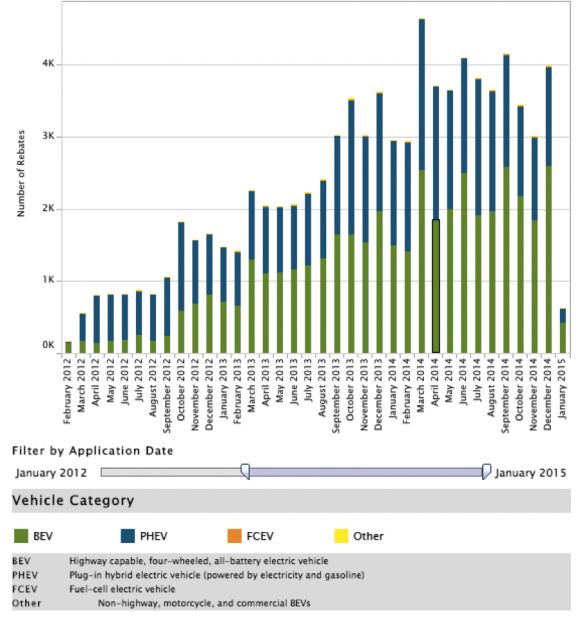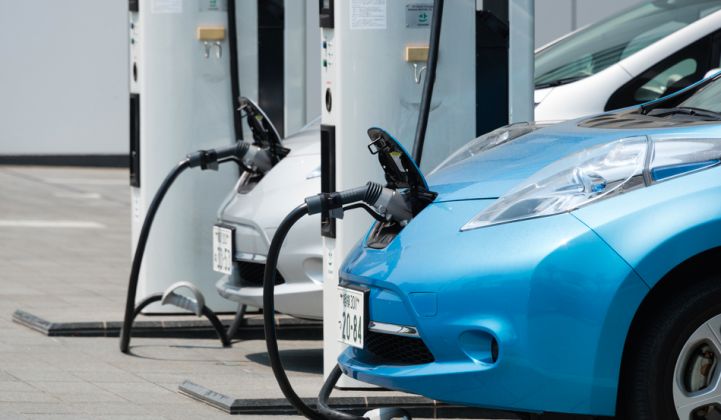GM made big news last week with the unveiling of the new plug-in hybrid Chevy Volt and the all-electric concept car they’re calling the Bolt.
The new Volt is a thing of beauty and immediately made me contemplate how to get out of my new lease on my little Fiat 500e. The all-electric range is now improved from 38 to 50 miles, and the normal hybrid drive mode fuel efficiency is also improved from 38 miles per gallon to 41 miles per gallon.
We don’t know the pricing yet on the new Volt, but let’s hope it continues the steep price reductions we’ve already seen with the Volt. In the low $30,000 range, it’s still far from a mass-market vehicle.
The new Bolt, scheduled to be available in 2017 or so, would be a game-changer because it is planned to be the first 200-mile-range all-electric at an affordable price. Yes, Tesla’s salivation-inducing machines get well over 200 miles of all-electric range, but they cost a pretty penny -- well over $80,000 when various add-ons are included. The Bolt, allegedly in the mid- to high-$30 range, will be less than half of the cost of the Tesla models currently available.
Tesla has also been working on its own affordable mass-market all-electric car for some time now, currently called the Model 3. It will also have about a 200-mile range and is supposed to be about $35,000. With the federal and state incentives currently available, the price will be reduced to the mid- to high-$20,000 range, which is indeed affordable for a large swath of the public. For example, my new Fiat 500e’s sticker price was about $32,000, but my lease is only $200 a month because of Fiat’s ability to absorb the $7,500 federal tax credit offered for electric cars and pass those savings on to consumers.
These are encouraging developments, to be sure. What has me worried, however, is the fact that we’ve seen EV sales dip in the second half of 2014. And with gasoline prices plummeting for various reasons, we’re likely to see that trend worsen in 2015, both in California and around the country. Here’s a chart showing California sales of EVs in 2014, based on rebate applications.

Source: Center for Sustainable Energy
California has a goal of getting 1.5 million zero-emission vehicles on its roads by 2025, and if we’re going to achieve that ambitious number, we need to see sales continue to grow exponentially, not slow down. Governor Brown also set a number of other mid-term goals in a 2013 executive order, as well as a goal of achieving an 80 percent reduction in greenhouse gas emissions by 2050.
The governor’s executive order is a far-reaching and visionary document. Unfortunately, it isn’t binding on the California Public Utilities Commission (CPUC), one of the key agencies explicitly tasked with implementing it.
Executive orders exist in a gray area of the law. Officially, executive orders allow governors to implement existing law by filling in additional details. So the governor can’t make law -- that’s the legislature’s role -- but the governor can help to implement existing law. The governor’s order in this situation may have overstepped this traditional role. But either way, one CPUC lawyer said that the commission doesn’t consider itself bound by executive orders.
That said, the CPUC should consider the executive order seriously in its policymaking efforts. There is, after all, a binding law that requires the CPUC to do what it can to effect the EV transition (SB 626, for example, which has been implemented by the commission).
So what can California do to get its EV transition back on track? What follows are the key ideas that come from my representation of the Green Power Institute and the Community Environmental Council at the CPUC in the EV proceedings, and my thinking more generally about how to achieve this transition.
1. Expedite approval of utility applications to build out the EV charging infrastructure rapidly
Establishing a robust statewide charging network will do much to solve the chicken-and-egg problem of instilling range confidence in potential EV owners.
SDG&E and SCE have submitted applications to the CPUC seeking approval to build out large numbers of new EV charging stations. SDG&E’s application would provide 5,500 charging stations in a five-year “pilot” program, and SCE, not to be outdone, has proposed a program for up to 30,000 charging stations. These numbers sound large, but they’re a small fraction of what needs to get built around the state in order to accommodate the 2025 goal of 1.5 million zero-emission vehicles on the road. Also, SDG&E and SCE both claim that their programs will be cost-effective, which means that the net benefits to ratepayers will outweigh the costs. If this is the case, there’s not much downside to such programs.
SCE has made it clear that it plans to own the infrastructure up to the actual charging facility, but the charging facility would be owned by third parties, so no anti-competitive effect would come from approving these large programs. SDG&E is less clear about who would own the charging facilities, but it’s likely that the CPUC will adopt the SCE approach for both. It’s also very likely that PG&E will soon submit its own similar program, because these programs do represent a major chance for the utilities to earn money for shareholders while also helping to achieve key state energy and climate change mitigation goals.
The CPUC should move quickly to approve these programs, but also ensure that they actually are cost-effective, and that any anti-competitive effect from utility ownership of EV charging infrastructure is minimized.
2. Dramatically expand education and outreach efforts by working with nonprofit educational organizations
Perhaps even more importantly, policymakers need to do a lot more to spread the word about the benefits of EVs. A lot of people still don’t know diddly about EVs and have no idea that there are now dozens of EVs and plug-in hybrids available.
There are also thousands of EV charging stations already installed in California, so while range issues are not a non-issue, there are many charging options already available in most urban areas. (The key is to add even more to avoid any possibility of justified range anxiety.)
The CPUC and other state agencies should work together to fund robust education and outreach efforts on EVs. Energy Upgrade California is a statewide program that is already doing a lot of education and outreach on energy issues, and it is a natural partner to ramp up EV education and outreach. This is also an active issue in the CPUC EV proceedings, and the CPUC should do its best to fund third-party efforts in this area.
3. Create a tariff that allows EV owners to earn money by absorbing excess solar power during peak production times
SDG&E’s application for EV charger ownership includes an innovative new rate schedule that would incentivize EV owners with smartphone and web apps to charge their cars when prices are at their lowest. Amazingly, California is already seeing excess solar production at times of peak production. In other words, we’re seeing too much solar power on the grid at times.
Excess solar is issue for PV power producers because they can potentially lose a lot of money. This problem is only growing worse as solar ramps up exponentially around the state. But if EVs can be marshaled en masse to suck up that excess solar power, we have a problem turned into a beautiful solution. Rather than losing that power or curtailing solar power facilities, EV owners could be paid money to absorb the excess solar power.
4. Improve the state rebate process
California has a state rebate of up to $2,500 for new EVs ($1,500 for new plug-in hybrids like the Volt). This is a nice bonus for EV owners because it’s not connected to taxes at all. The application process is fairly simple and is run by the Center for Sustainable Energy, a San Diego-based nonprofit. However, the time it takes to receive the rebate is ridiculously long: 90 days upon application approval -- and approval itself can take up to a month.
I’ve learned that there seems to be a law of the universe at play whenever it comes to getting reimbursements, rebates or similar financial payments: they always seem to take months to arrive. Why is this the case in the era of electronic money transfers that take seconds? This needs to change. There's no reason the state rebate process couldn’t be improved so that the whole process is largely automated and checks are issued within hours of application submission.
5. Increase the state gas tax and funnel receipts back into rebates for EVs
The state gas tax is currently at 39.5 cents per gallon, which is in addition to 18.5 cents/gallon in federal tax. The average price at the pump has plummeted in the last few months to about $2.50/gallon. This is a great windfall for consumers and a nice boost for the economy. It’s also a good time for legislators to contemplate raising the state gas.
No one likes higher taxes, but there are some compelling reasons for raising the gas tax. First, higher prices discourage consumption and we all benefit with lower petroleum consumption. We can also incentivize more efficient vehicle purchases, like EVs, and other forms of transportation, because the newly low gas prices are already causing a big uptick in truck and SUV sales. The biggest benefit, however, could be to turn the additional revenue into better rebates for EVs.
Georgia had a $5,000 state rebate for EVs until recently. California, as mentioned, has up to $2,500. But we should increase that figure to $5,000 as a major boost for EV sales. That subsidy should be phased out over time, as is happening with the current subsidy, because we don’t want to create a long-term dependency. We also don’t want to incentivize automakers to keep EV prices higher than necessary by offering a higher rebate.
At this time, with EV sales dipping dangerously, we need to consider all the options for getting sales back on track.
***
Tam Hunt is a lawyer and owner of Community Renewable Solutions LLC, a renewable energy project development and policy advocacy firm based in Santa Barbara, California and Hilo, Hawaii.



